Harit Pradesh is a proposed new state of India comprising the western parts of the state of Uttar Pradesh.[1] The etymology derives from harit, meaning 'green', and pradesh, meaning 'state'. Other proposed names include Braj Pradesh (which would include only parts of this region)[2] and Paschim Pradesh.[3] It consists of an area of 79,832 km2, which is 33.14% of UP and a population of 7.42 crores, which is roughly 35-36% of UP.[4]
Harit Pradesh | |
|---|---|
Proposed state | |
 Location of Harit Pradesh in India | |
| Country | |
| Region | Northern India |
| Proposed capital | Meerut |
| Proposed Divisions | |
| Language | Khadiboli and Braj bhasha |
The region has some demographic, economic and cultural patterns that are distinct from other parts of Uttar Pradesh, and more closely resemble those of Haryana, Punjab and North Rajasthan areas. For instance, dialects of Hindi spoken here (Khadiboli and Braj Bhasha) are distinct from Bhojpuri spoken in Purvanchal and Awadhi in Central UP. Similarly, some of the festivals like Chhath puja are also significantly more popular in Purvanchal compared to Western Uttar Pradesh.[5]
Proposed capital
Meerut has been constantly proposed as the capital of this state by many leaders, including Dr. B.R Ambedkar,[6] former Chief Minister Mayawati, and Union Minister Sanjeev Balyan.[7][8]
Ambedkar had also proposed that the state of U.P. must be divided into at least three different states, with each region having the centrally located capital and had proposed Meerut, Cawnpore (now Kanpur), and Allahabad in these regions as their respective capitals.
History
In his 1955 critique of the proposed States Reorganisation Act, Thoughts on Linguistic States, Dr. B. R. Ambedkar had advocated the division of Uttar Pradesh into three states – Western, Central, and Eastern, with capitals at Meerut, Kanpur and Prayagraj, respectively – in order to prevent excessively large states from dominating politics at the national level.[6][9]
Later, socialists like Ram Manohar Lohia, Jayaprakash Narayan and Acharya Kripalani favoured a re-drawing of the administrative map of India. However, Jawaharlal Nehru, the prime minister at the time, supported the States Reorganisation Commission's (SRC) recommendation of re-forming states on a linguistic basis. K.M. Panikkar, in his dissenting note to the SRC report, however, opposed linguistic states and preferred the formation of a state of western Uttar Pradesh.[10]
In 1972, fourteen MLAs in the Uttar Pradesh state assembly supported an unsuccessful resolution to divide the state into three units (Braj Pradesh, Awadh Pradesh and Purvi Pradesh).[11] A similar resolution, however, was successfully passed from the state assembly in 2011 under then Chief Minister Mayawati.[12]
Regional disparities
Western UP alone accounts for more than 50% of the Gross State Domestic Product (GSDP) of Uttar Pradesh.[13] By comparison, Bundelkhand contributes just 5.2%, Central UP 17.52% and Eastern UP 28%. Out of top 10 districts that contribute the most to state GSDP, 7 are from Western UP.[14] In terms of Per Capita Gross District Domestic Product (GDDP) as well, 7 out of top 10 districts in the state are from Western UP. These include (in descending order):[13]
| Top districts by contribution to GSDP | Top districts by per capita GDDP |
|---|---|
| Gautam Buddha Nagar | Gautam Buddha Nagar |
| Agra | Meerut |
| Meerut | Etah |
| Ghaziabad | Agra |
| Bareilly | Amroha |
| Bijnor | Ghaziabad |
| Bulandshahar | Hapur |
In FY 21–22, the total GDDP of Western UP region on market prices was 9.44 lakh crores while that of entire UP was 19.17 lakh crores.[13] Constant GDDP of Western UP during the same period was 5.89 lakh crores, and for entire UP it was 11.81 lakh crores.[14] Based on these figures, the per capita GDDP of Western UP turns out 79,425.47 INR, much higher than that of all UP at around 59,065 INR.
Western UP is also ahead of the rest of UP in terms of infrastructure, industrialization, urbanization, and overall quality of life. Some of its cities (i.e. Noida and Greater Noida) are on par with largest metro cities of the country. Even among smaller cities the quality of life is better compared to the rest of UP, as most of them are Tier-2 cities. Nine out of 15 tier-2 cities in the state are in Western UP.[15]
Additionally, Western UP also accounts for almost 54% of all court cases reaching Allahabad High Court, which is on average around 500 km away from the cities of this proposed state and requires travelling all day for a simple hearing. Residents of western Uttar Pradesh have been demanding a high court bench in Meerut from a long time, but so far it hasn't been heard.[16][17]
These huge economic disparities give people in Western UP a sense of having to pay up for the economic backwardness of other regions in their state.[18][19] Additionally, the prospect of being clubbed with economically backward state of Bihar in general conversation with terms like "UP-Bihar", despite having a far more developed and advanced economy than Bihar, also doesn't go down well with the people in this region. These feelings, when combined with cultural differences and other incidents, such as having to struggle for a high court bench for decades,[17] and allegations of lower allocations in state budget,[20] further increase the discontent among politically aware people of the state, thus fueling the demand for statehood of this region.
Proponents and opponents
Political parties and leaders
Among the most prominent advocates for the creation of the new state in recent days have been BSP Supremo Mayawati and Late Chaudhary Ajit Singh, the son of former Prime Minister Chaudhary Charan Singh and leader of the Rashtriya Lok Dal (RLD).
After coming to power, Mayawati wrote letters to the prime minister three times in 2007, March 2008, and December 2009 regarding partitioning of Uttar Pradesh.[21][22] In November 2011, Mayawati's cabinet also passed a resolution in State assembly to partition the state into four different states—Harit Pradesh, Awadh Pradesh, Bundelkhand and Purvanchal—for better administration and governance.[12][23] However, since creating states is the domain of Central Government and the proposal wasn't actively taken by the UPA Government of that time, it couldn't be implemented.
Similarly, RLD also pushed for the statehood of Harit Pradesh in 2011. Pushpendra Singh, former General Secretary of Youth wing of RLD, even launched a political party called Harit Pradesh Party to demand the creation of a separate state of Western Uttar Pradesh. In 2011, Chaudhary Ajit Singh of RLD said:[20]
"Western UP contributes to a large chunk – nearly 72% – of the state's total income. In turn, what western UP gets is not enough. Just 18% of the state's budget is spent on developing west UP. This anomaly, understandably, makes the people of this area dissatisfied".
He also alleged that in most years, funds allocated to west Uttar Pradesh were never spent.
Other Jat leaders, such as Om Prakash Chautala in Haryana, the leader of the Indian National Lok Dal, have also made efforts to involve themselves in the politics of creating a separate state.[24]
Of the other main political forces in Uttar Pradesh, the Samajwadi Party has opposed the proposal, while the Indian National Congress and BJP have adopted a non-committal stance.[25] Individual leaders of both Congress as well as BJP, however, have time and again spoken in favor of the statehood for Harit Pradesh. For instance:
- After the Congress working committee passed a resolution to recommend the creation of Telangana on 31 July 2013, Jairam Ramesh suggested that Uttar Pradesh's reorganisation was necessary as it is difficult to run such a big state effectively.[26] He said:
"From an administrative point of view, a state of over 200 million people, 75 districts, over 800 blocks ... It's just not governable. It is my personal view...Its politics is a separate issue."
- Similarly, BJP leader Sanjeev Balyan also said while attending a university event in Meerut that Harit Pradesh should be a separate state with Meerut as its capital.[7] He clarified though that this is his personal opinion and not the official party line.
In April 2024, while campaigning for Lok Sabha elections Mayawati again raised the issue of statehood for Western Uttar Pradesh, promising to take "concrete steps" for the same if her government came to power.[27]
Communities
The creation of three new states in 2000 (Jharkhand from the division of Bihar, Uttarakhand from the division of Uttar Pradesh, and Chhattisgarh from the division of Madhya Pradesh) gave new impetus to the demand for Harit Pradesh among communities.[28] The support further increased after formation of Telangana out of Andhra Pradesh in 2013.[29] The Jats of this region, who are a dominant political and agricultural community spread across Pakistan, Punjab, Haryana, Rajasthan and Uttar Pradesh, have found themselves in a "politically disadvantageous position" in western Uttar Pradesh.[28] Therefore, they are largely in support of statehood for Harit Pradesh.
Also, since the Muslim population in western Uttar Pradesh (24%, according to 2011 census) is higher than in Uttar Pradesh as a whole (17%), the proposal has found support from Muslim organizations as well.[30][31][32][33]
Geography
Soil conditions
Western Uttar Pradesh's soil and relief has marked differences from that of the eastern part of the state.[34] The soil tends to be lighter-textured loam with some occurrences of sandy soil.[35] Some loess soil is continuously deposited by winds blowing eastwards from Rajasthan's Thar Desert.[36]
Precipitation
Harit Pradesh receives rain through the monsoon and western disturbances. The monsoon carries moisture northwards from the Indian Ocean, occurs in late summer and is important to the Kharif or autumn harvest.[37][38] Western disturbances carry moisture eastwards from the Mediterranean Sea, the Caspian Sea, and the Atlantic Ocean.[39][40][41][42] They primarily occur during the winter season and are important for the main staple of the region, wheat, which is classified as a rabi crop.[40]
Demographics
Languages of Harit Pradesh
Khadiboli in Harit Pradesh
Khadiboli in North Part of paschim Uttar Pradesh (Harit Pradesh). Khadiboli speaking districts are Muzaffarnagar, Sharanpur, Shamli, Bagpat, Ghaziabad, Meerut, Hapur, Amroha, Bijnor, some part of (Muradabad, Gautam Buddh Nagar, Bulandshahar), etc.
Braj bhasha in Harit Pradesh
Braj bhasha in Southern Part of Harit Uttar Pradesh. Brajbhasa speaking districts are Mathura, Agra, Aligarh, Mainpuri, Etawa, Hathra, some part of (Gautam Buddh Nagar, Bulandshahr, Etawah, Mainpuri), etc.
People of Harit Pradesh
The unique setup of Western UP arises largely from the castes engaged in agriculture like the Jats , Yadavs, Gurjars, and Rajputs. The region in 1980s and 1990s was witness to the "sugarcane mafia" led by the above-mentioned communities.[44][45] Yadavs and Hindu Rajputs have a very small presence in this region.[46] Jats, Brahmins, Gujjars make up to 42% of the population of the western region of Uttar Pradesh. And Jats community is largest community in this Region.
Community in City AreasThe Brahmins, Jats, Baniyas, and Jain community groups are dominant in political and social status.
Community in Village AreasThe Jats, Gujjars, Yadavs and Muslim Rajputs community groups are dominant in political and social status.
"Jats are only Community which are dominant in both city and village areas in Harit Pradesh."
According to the 2011 census of India, the total population of Western Uttar Pradesh is 71,740,055 people. It is composed of a varied set of communities and tribes, including:[47] the Jats, Gurjars and Yadav are These castes comprise nearly 60 per cent of the population in Meerut, Mathura, Ghaziabad, Noida, Bagpat, Muzaffarnagar, Shamli, Saharanpur, and Bijnor districts. Jats cultivate almost land of Western Part of Uttar Pradesh known as Harit Pradesh. Gujjar and Yadav, also cultivate their own land.
Harit Pradesh have 98 seats in Uttar Pradesh. According to community groups = Baniyas have directly influence 1 seats, Muslim Jats have directly influence 2 seats, Rajputs have directly influence 3 seats, Muslim Gujjars have directly influence 3 seats, Yadavs have directly influence 4 seats, Brahmins including Tyagis have directly influence 6 seats, Muslim Rajputs have directly influence 6 seats, Dalits have directly influence 9 seats, other castes like SC/ST, Saini, bhumihar and Prajapati voters influence 10 seats. Gujjars have directly influence 11 seats.Jats is largest dominant community in this region. And Jats having a directly influence 43 seats in Western Uttar Pradesh Elections. So That regain Harit Pradesh known as Western part of UP's Jatland.[48][49]
Community groups in Harit Pradesh
- Jats: 27%
- Gujjars: 7%
- Yadav/Ahir: 3%
- Muslim Rajput: 5%
- Baniyas: 2%
- Brahmin: 5%
- Dalits: 12%
- Lodhi: 3%
- Tyagi: 2%
- Rajputs: 2%
- Ranghar: 2%
- Rayeen: 2%
- Other caste: 8%
In 2023The unique setup of Western UP arises largely from the castes engaged in agriculture like Tyagis, Jats , Yadavs, Gurjars, and Rajputs. The region in 2000s and now's time were witness to the "sugarcane mafia" gang by the above-mentioned communities.[44][45] Yadavs and Hindu Rajputs have a small presence in this region.[46][48][50]
Administrative divisions

Western Uttar Pradesh includes 26 districts in six divisions:
- Saharanpur division: Saharanpur, Muzaffarnagar, Shamli districts
- Moradabad division: Moradabad, Bijnor, Rampur, Amroha, Sambhal districts
- Bareilly division: Bareilly, Badaun, Pilibhit, Shahjahanpur districts
- Meerut division: Meerut (Proposed Capital), Bulandshahr, Gautam Buddha Nagar, Ghaziabad, Hapur, Baghpat districts
- Aligarh division: Aligarh, Hathras, Kasganj, Etah districts
- Agra division: Agra, Mathura, Firozabad, Mainpuri districts
Education
| School | Location | Established | Comment | Ref. |
|---|---|---|---|---|
| Aligarh Muslim University | Aligarh | 1920 | Aligarh Muslim University is a public university funded by the Government of India. It was originally established by Sir Syed Ahmad Khan as Mohammedan Anglo-Oriental College in 1877. | [51] |
| Chaudhary Charan Singh University | Meerut | 1965 | The university is named after Chaudhary Charan Singh, the fifth Prime Minister of India. | [52] |
| Dr B. R. Ambedkar University | Agra | 1927 | This university was formed as Agra University and renamed in 1996. | [53] |
| Gautam Buddha University | Greater Noida | 2002 | [54] | |
| M. J. P. Rohilkhand University | Bareilly | 1975 | M.J.P. Rohilkhand University was established in 1975 as an affiliating University. The senior faculty members of different disciplines in Humanities, Science and Technology are running research projects funded by various agencies and so far 49 projects funded by UGC, AICTE, DST, CST, ICAR, ICHR, MIF have been completed. | [55] |
| Sardar Vallabhbhai Patel University of Agriculture and Technology | Meerut | 2004 | [56] | |
| Teerthanker Mahaveer University | Moradabad | 2008 | Teerthanker Mahaveer University is a private university in Moradabad, Uttar Pradesh. | [57] |
| Glocal University | Saharanpur | 2012 | Glocal University is a private and coeducational institution located in Saharanpur, Uttar Pradesh, India. It is situated in the foothills of Shivalik mountains. | [58] |
| Invertis University | Bareilly | 2010 | [59] |
Special economic zones
Transport networks
Major state and national highways and other public transport systems in the proposed area include:
- DND Flyway
- Noida Greater Noida Expressway
- Delhi Meerut Expressway
- Delhi Meerut RRTS
- Ganga Expressway
- Yamuna Expressway
The major highways running through the intrastate region include:
Most populous cities
| Most populous cities | ||||||||||
|---|---|---|---|---|---|---|---|---|---|---|
| City | District | Population | City | District | Population | |||||
| 1 | Ghaziabad | Ghaziabad | 2,381,452 | 7 | Saharanpur | Saharanpur | 705,478 | |||
| 2 | Agra | Agra | 4,418,797 | 8 | Noida | Gautam Budh Nagar | 637,272 | |||
| 3 | Meerut | Meerut | 3,309,023 | 9 | Muzaffarnagar | Muzaffarnagar | 495,543 | |||
| 4 | Bareilly | Bareilly | 898,167 | 10 | Mathura | Mathura | 601,894 | |||
| 5 | Moradabad | Moradabad | 889,810 | 11 | Budaun | Budaun | 369,221 | |||
| 6 | Aligarh | Aligarh | 874,408 | 12 | Rampur | Rampur | 325,248 | |||
| Source: Census of India 2011[60] | ||||||||||
The region's Jat are descended from immigrant groups from centuries ago, and a large subregion of western Uttar Pradesh, Jatland, this name takes from Jats tribe.[61] confined primarily to the west Uttar Pradesh Southern part and In North part of Western Uttar Pradesh, Meerut and Sharanpur divisions of Uttar Pradesh. Jat are generally considered to have come either from Rajasthan and haryana or from the Panjabi-speaking tribes of the North-West.
Sikh Jats came from West Punjab, who migrated from Pakistan after partition, also settled in this area in large numbers.[62]
In Pop Culture
In 2022, a social comedy film titled Dasvi showed protagonist Abhishek Bachchan as the Chief Minister of Harit Pradesh. The film was premiered on Netflix and JioCinema.[63]





